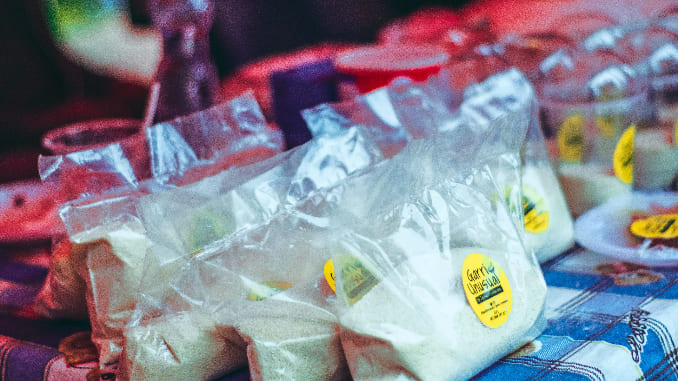What to Know About Garri, Nigeria’s Widely Available Staple and Family Tradition
Photo by John Onaeko/Unsplash
Refreshed, full and energetic. That’s how a cup of soaked garri makes me feel, especially when I accompany it with cold water, condensed milk and a piece of fried fish on a very hot afternoon, just after getting home from work. I’m a school teacher, and seeing my learners bring garri to school often makes me reminisce on my childhood days when garri was the order of the day. Even so now. I love how the staple feels in my hand when I scoop and pour it into my mouth, like a handful of fine sand, only it’s not sand but an edible food made from cassava. The way its sharp tartness slaps my palate within the first few seconds makes me think of how life can be so hard when you’re just starting out but then becomes bearable and even sweet when you persist and pursue your goals doggedly.
Garri is a staple produced from the tuberous roots of freshly harvested cassava through a series of processes. First of all, the cassava roots are cleaned, peeled and grated into granules. Afterward, the resulting cassava mash is put in sacks, which are then placed between heavy planks and tightened with a strong rope. This is done to squeeze water and starch out of the cassava mash. It is left there to dry and ferment for days and then fried either in palm oil or without it. The preparation of garri is one of the most arduous and back-breaking processes of food production, yet garri remains one of the cheapest and most readily available food items in Nigerian markets today. Because of its wide consumption nationwide, it’s easy to spot households that own a mill where they process garri for sale.
In many Nigerian homes, garri is not a scarce commodity. A truly versatile and ridiculously affordable food, it prides itself as every common man’s food because of its year-round availability. Garri can be eaten in different forms. It can be taken as a light meal (snack) when soaked in water or as a solid meal (swallow) when added to hot water and kneaded into a dough to make ebà, which is then served with a choice soup. In its dry form, garri can also be added to soft cooked beans and palm oil to make a solid chunk. Whichever way you choose to take your garri, you can never go wrong with it.
But anyone could tell a well-processed garri from a poor one. The grains should be crispy, dry and lacking foreign materials. Depending on how and when garri is processed, the final output can vary in taste, color, grain size and swelling capacity. The most popular types are Ijebu garri, produced in the southwest by the Ìjèbu people of Yorùbá origin, and Igbo garri, produced by the Igbo people of Eastern Nigeria. Ijebu garri is white and has a more pleasant sour taste because it’s usually fermented for a longer period during production, while Igbo garri is coarser and can be either white or yellow, as it’s made from yellow-skinned cassava or white cassava mash fried with palm oil. To avoid buying garri that wouldn’t meet their expectations in regard to taste and crispiness, you’d normally find a Nigerian buyer scooping some garri into their mouth to ascertain its quality before buying. Many can’t afford to buy and take a bad garri home. Better to test the waters before plunging into the deep rather than drowning in the tastelessness of a bad decision.
As with many facets of Nigerian life, the practice of drinking soaked garri is now almost inextricable from the diet of most Nigerians. Soaked garri with sugar formed the basis of a good afternoon meal when I was growing up. In those days, whenever we got home from school and told our father that we were hungry, he’d simply say “E lo mu garri” (go and drink garri). And that’s almost always true for other families too because it’s readily available.
For many Nigerians, soaked garri can easily serve as an easy-to-grab afternoon meal because of its affordability. It can be taken with sugar, groundnut, dried meat, fried fish, akara (bean cake) or sauced ponmo (cow skin) depending on one’s choice. Some people drink their soaked garri with accompaniments like raw pepper and salt. And some drink it just like that. In truth, there’s no one way to drink a cup of soaked garri.